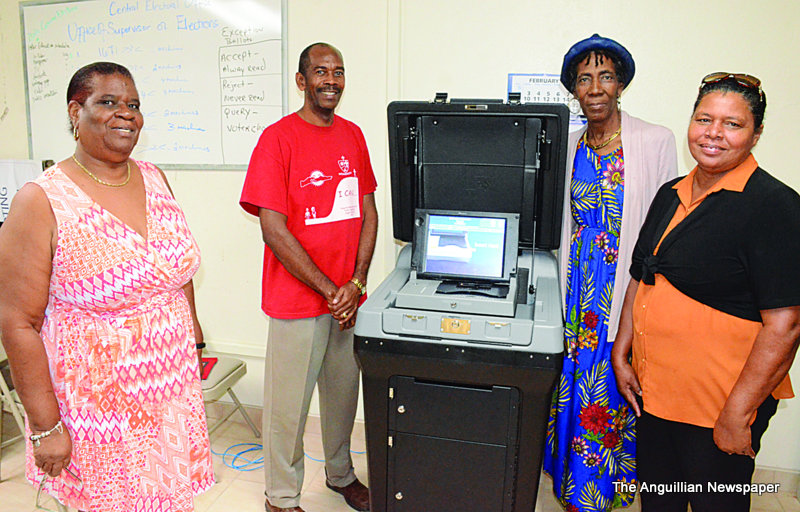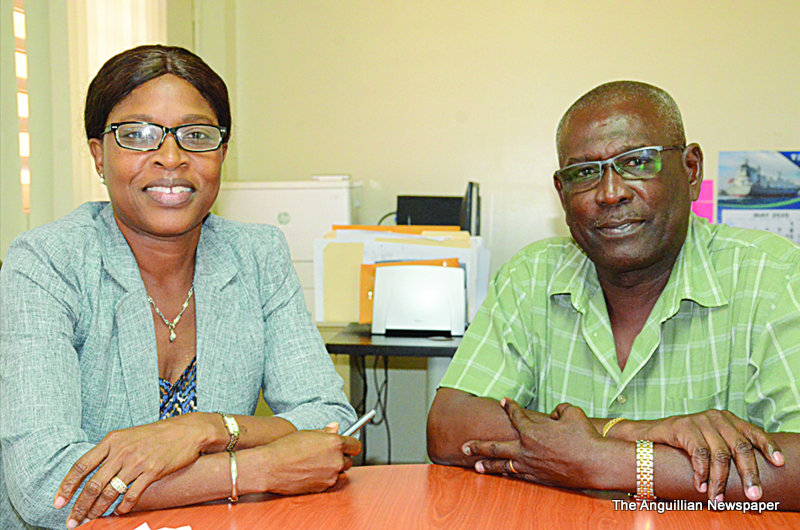
Returning Officers learning electronic voting machine
The coronavirus may have thrown a wrench into a lot of plans and decisions in Anguilla, but one thing that is a must is the holding of the district and island-wide elections now constitutionally due.
Of course, provisions like an Order-in-Council, in the British Parliament, have had to be devised just in case there is to be a need for an extended date for the elections, but plans are nevertheless in place for polling sooner or later.
“We are getting ready for the voting,” Supervisor of Elections, Mr. Rodney Rey, told The Anguillian newspaper days before and after the Anguilla House of Assembly was dissolved. The long-expected dissolution of the House, with a lifespan of five years, from 2015-2020, came into force through a Proclamation, by Governor Tim Foy, OBE, dated Saturday, May 9, 2020. This came after the House, dominated by the then ruling Anguilla United Front, passed a bundle of pending draft legislation as well as a number of duty-free concessions.
Mr. Rey and his Deputy Supervisor, Mrs. Maria Hughes, whom he lavishly praised as his knowledgeable right-hand support, spoke to the newspaper which a number of Returning Officers and Polling Clerks were being trained. The training, supervised by Mrs. Daphne Jacobs-Richardson, one of the senior electoral officers, was with respect to the use of the tabulation machines.

Meanwhile, May 6, the Central Electoral Office published a revised list of voters in each of the seven constituencies as well as online. That list registered some 12,080 potential voters in Anguilla including Anguillians living abroad. They were registered over the past five years. It is expected to be further amended following a period for objections to names to produce the actual list for the upcoming polling voting. The above number compares with over 10,909 voters who were registered for the 2015 general election.
“We will be accepting objections and claims up to Friday, May 15, and there will be hearings in this office,” Mr. Rey explained. “After that date, the list will be further revised and we will then publish what is called ‘the Revised Preliminary List’ which becomes the register of voters for the elections. This list that went out on May 6 incorporates the persons who were registered in the last quarter up to February 21, minus those persons who were objected to or whom the Supervisor of Elections had reason should not be on the list. The final list will be out by the first of June.
“Training is now in progress with both morning and afternoon sessions. Electoral Officers are coming in for the training and interaction with the machines. So to speak, the machinery is being oiled, as we speak, in preparation for the election once it is called.”
For some time there had been training sessions in the electoral districts on the use of the electronic voting machines, but unfortunately this was halted as a result of the lockdown from the coronavirus. “We will be going back into the public,” said Mrs. Hughes, the Deputy Supervisor of Elections. “We really want to take those machines with us so that persons can have a firsthand chance to learn how they operate. We took a machine with us initially to our first set of training sessions. Persons saw what it looked like but we now want to now take the machine, along with a ballot box to the districts. We also have some sample ballots so that persons can have a feel as to how to use an actual machine and the ballot.
“That is our intention. In the next couple weeks we want to do that. It will be more or less an exercise to utilize the machine as opposed to having a sit down and discussion session with us telling persons what happens on election day. We understand that we still have to practice social distancing because of the covid-19 disease. We expect that once we have the machine we will get a crowd – more than the 25 persons required at an event, and the social distancing period doesn’t end until May 31. We will be more prepared to start the public interactions with the machine by early June.”
One way of demonstrating the use of the machine is to have the first 25 persons at a time at the session, and then another 25 afterwards, it was suggested.
“We have had training already in all the districts except Road North, where there was another function,” Mr. Rey stated. “Then we were supposed to go back to District 2, Sandy Hill, where only one person was in attendance. I think more people are going to come out once the election date is announced and there will be increased enthusiasm. If time permits, we will go again into all the districts with the machine to see how it will operate with the ballots.”
Asked how difficult it may be for some persons to know how to do the electronic voting, Mr. Rey replied: “It is not rocket science that they can’t understand. If anybody has any difficulty, he or she can take a friend to vote for them. That is in the Elections Act. It includes the illiterate, the blind or any other handicapped person. The system is user friendly. The only difference is that traditionally there was only one candidate to choose – now there are five and it may take a little longer. You have to read the ballot with the island-wide candidates on the right-hand side. That will take some time. The names will be in alphabetical order and not according to parties so one has to search downwards for the candidate of choice. And of course, the names of the district candidates will be on the left-hand side of the ballot.”
The Supervisor of Elections was asked how long it would take to have the ballots printed. “We have started that process,” he responded. “We are giving the information to the printers. This year the ballots are going to be printed in the United States by the suppliers of the machines. The ballots must be done on special paper. Traditionally, the ballots were printed in St. Maarten and brought to Anguilla on the police launch. Now, because we have the electronic machines, the ballots will be printed by the supplies of the machines that also have the special paper. The company, Electronic Systems Software (ESS), is located in Michigan.”
Asked about the possibility of Anguillians abroad being able to come to Anguilla to vote on the specific date when the elections are called, Mr. Rey said: “The conditions include Anguilla being not on lockdown; its borders are opened; and people who are registered have the chance to come in if they want to come. If Anguilla is still lockdown, is it fair to say that the election should be held when somebody wanted to come in to vote and couldn’t do so? That is a consideration. If the island is locked down, or other countries are locked down, and we have the polling during that period, persons who would have been here to vote, might claim they were disfranchised. It is call one has to make.”
Meanwhile, many of the machines needed for the voting are already in Anguilla, one of which is being used for training persons in the districts as well as the Electoral Officers. “We have sixteen in stock right now and another five are in Florida awaiting shipment,” Mr. Rey disclosed. “Since we have twenty polling stations in the seven districts, we want every polling station to have its own machine to speed up the voting process.”
What is the cost of the machines and the software? “It is just over 150,000 US dollars,” Mr Rey said. “The Anguilla Government paid 50 percent of the cost, and the Foreign and Commonwealth Office and the Governor’s Office paid the other 50 percent. This equipment puts Anguilla among the very few territories in the region that invested in this kind of hardware and software.”







